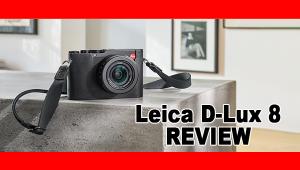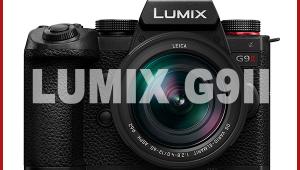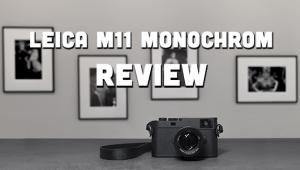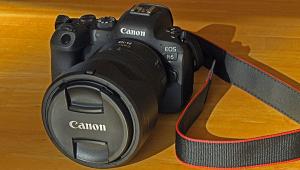Leica’s M8; Does The 10MP Digital Leica Live Up To The Leica M Legend? Page 2
A New Click
When you fire the M8's shutter, the actual click is pretty quiet but higher pitched than that of a classic Leica M. However, this is quickly followed by a whir that lasts about a second on S and 1/2 sec on the C setting as the motor cocks the shutter. Overall, the M8 is not as whisper quiet as the MP or M7, even though the engineers have gone to considerable lengths to keep it as noiseless as possible (e.g., using special low-noise motor and rubberized gears in the wind mechanism to even out and damp the noise). Happily, the action of the three-step shutter release (which turns the meter on, and provides memory lock in A mode) is very smooth and predictable. After a few hours of shooting we got used to the M8's distinctive sound--and the absence of a wind lever (!)--and didn't find it obtrusive or objectionable, but a few Leicaphiles we spoke with continue to gripe about it, and also about the lack of a full-frame sensor, even though the latter was not technically feasible and would have made the M8 larger and more expensive. Whenever you transform a beloved classic you're bound to generate some grumbling.
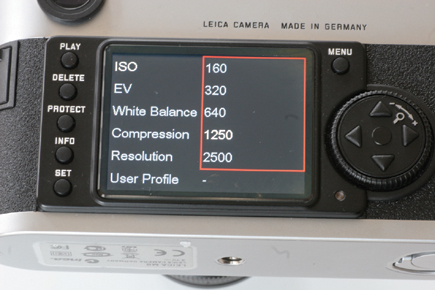 |
|
|
Controls A Film Shooter Can Love
In configuring the M8's mode and menu controls, the designers wisely made them as simple, logical, and intuitive as possible for film shooters making the transition to digital. All are clustered on the sides of the LCD on the back and are activated by turning the main power switch from OFF to any powered setting (S, C, or self-timer).
Press the Set button alone and the LCD displays the main operational menu that lets you set and select ISO (160-2500), EV (exposure compensation to +/-3 stops in 1/3-stop increments), White Balance settings (Auto, Tungsten, Fluorescent, Daylight, Flash, Cloudy, measured Manual settings, and Kelvin settings between 2000 and 13,100), Compression (DNG raw, JPEG fine, JPEG basic, DNG+JPEG fine, and DNG+basic), and Resolution (10-megapixel, 6-megapixel, 2.5-megapixel, and 1-megapixel).
A second menu of subsidiary controls, which are selected and set in similar fashion, is displayed when you press the Menu button to the right of the left-hand upper corner of the screen. Its settings include Lens Detection (enabled or not), Save User Profile, Self-timer, Sharpening, Color Saturation, Contrast, Monitor Brightness, Histogram (standard or RGB with or without clipping to indicate overexposure), etc. While other cameras may offer even quicker ways of accessing frequently used modes and settings, Leica is to be commended for coming up with a simple, logical, and consistent control system that's user-friendly for traditional M users as well as experienced digital shooters.
 |
|
|
Selecting and assessing your recorded images is equally straightforward with the M8. Turn on the power, press the Play button to display the last image shot, and press the left and right pointing buttons within the circular control array to the right of the LCD to scroll back and forth and select the image you want. To assess the details in the displayed image, turn the detented mode control dial clockwise to select successively greater viewing magnifications of the displayed image, as indicated by a square in a frame icon in the lower right-hand corner of the screen. All in all it's a very clever, well executed, and logical system for image evaluation, and while it doesn't really break any new ground, technically it's as good as anything out there and more straightforward and transparent than many others.
Handling
Shooting with the Leica M8 is a real pleasure. The camera nestles in your hands more comfortably than the average D-SLR and the viewfinder read-outs are refreshingly simple. Set the shutter dial to "A" (Aperture-Priority), set your shooting aperture via the traditional click-stopped manual f/stop ring on the front of the lens (!) and the camera-selected shutter speed (denominator) appears in half-step intervals in red LCD numerals at the bottom, center of the finder field. If the correct exposure cannot be achieved at the aperture/ISO combination using the available shutter speeds, the display flashes. If you set a manual shutter speed, the display changes to a three-LED display, with a central dot denoting the correct exposure flanked by right- and left-pointing directional arrows indicating the proper direction to turn the aperture ring to set the correct exposure.
As previously mentioned, the viewfinder frame lines cover prime (single focal length) lenses ranging from 24-90mm. These auto-indexing frame lines appear in pairs, 24 and 35mm, 50 and 75mm, and 28 and 90mm, all corresponding to the actual recorded image with these focal lengths. In other words, they include the 1.33x extension factor resulting from a smaller-than-full-frame sensor. Only a limited number of coded Leica M lenses were available at test time and we chose two pricey beauties, a 35mm f/1.4 Summilux-M ASPH and a 21mm f/2.8 Elmarit-M ASPH. We chose the 35mm because it provides a coverage angle equivalent to a 46.6mm lens on the M8--close to the classic 50mm. The 21mm provides equivalent coverage to a 28mm lens (sans extension factor) so we mounted a 21-28mm auxiliary finder in the hot shoe and set it to 28mm.
 |
|
|
Putting It To The Test
We shot well over 1000 images with both Leica lenses using the full range of ISO settings and photographing a wide range of indoor and outdoor subjects. Exposures ranged from 1/8000 sec to 4 seconds and the lighting ranged from sunlit to cloudy bright, overcast, and tungsten-illuminated. We shot nearly half our test pictures with the camera mounted on a heavy Gitzo tripod; the others were handheld at various shutter speeds. We also took a few flash pictures with a non-dedicated flash unit just to check the flash sync and color balance, but the dedicated TTL Metz unit was not yet available. We did not shoot any long-time exposures. All test pictures were taken at the DNG+JPEG fine and 10-megapixel maximum resolution settings. Incidentally, Leica chose the Adobe DNG as the M8's raw file format because the company feels it is "more future-secure" than other camera manufacturer-based raw formats.
To assess the M8's image quality, we shot a series of comparison test pictures using the M8 with the 35mm Summilux lens against a full-frame 12.8-megapixel Canon EOS 5D with a 50mm f/1.4 Canon lens. Both cameras were affixed to a sturdy tripod without extending the center post, and all pictures were shot at f/8 to minimize variables due to focusing errors. The subject was a landmark Victorian house with many fine details, and we also included a Sharpness Indicator (copyright by Ivan Putora) containing a series of circular line patterns in each scene. We also shot a series of pictures of another historical building with the M8 and 35mm f/1.4 Summilux alone to gauge the camera's performance at all ISO settings--160, 320, 640, 1250, and 2500.
Overall, we judge the imaging performance of the Leica M8 to be outstanding. As expected, the well-proven rangefinder provided swift and precise manual focusing even in low light and with low-contrast subjects, and we found the image quality to be on a par with a high-end D-SLR. As with previous Leica M's, camera-induced vibration was low, allowing us to shoot sharp pictures at slower shutter speeds than usual. We made 13x19" prints of about a dozen images, both tripod-mounted and handheld shots, and a couple of 16x20s of the tripod-mounted test pictures. All were impressive in terms of detail rendition, saturation, and contrast, and the performance of the M8's heavily center-weighted metering system was above reproach, delivering spot-on exposures nearly 98 percent of the time.
In comparing images shot with the M8 vs. the 5D, we found there was surprisingly little difference. Both are virtually equal in terms of observable sharpness, though the M8 images seem to have a tad more contrast while the 5D images show a bit better color neutrality. The Leica M8 images in the comparison test were a smidgen warmer than those of the Canon 5D, both in the whites of the test target and the yellow of the house--easy enough to adjust in Photoshop, with the Capture One software supplied with the M8, or by making a Custom White Balance setting. The fact that the 10-megapixel M8 can play in the same ballpark as the widely acclaimed 12.8-megapixel 5D is a testament to the fact that Leica's engineers, and the Danish manufacturer Phase One, who did the laborious work of camera profiling and software configuration, have really done their homework in optimizing its image quality. It is also possible that some of this excellent performance is attributable to the superiority of the Leica's rangefinder focusing system, which some experts claim is inherently more precise than the autofocus systems in D-SLRs.
As for the M8's ISO performance, we feel safe to say that you'll see little difference in images shot at the minimum ISO of 160 and at 320. At ISO 640, you can see very slightly more noise than at ISO 160, but with 10-megapixel capture shooting using DNG or JPEG fine files, this is a very useable setting, even for high-magnification enlargements. At ISO 1250 moderate to medium noise is visible and it's definitely more evident at ISO 2500. You can certainly reduce the noise to tolerable levels in postproduction but you won't be able to fix it fully in the light version of Capture One supplied with the M8, which only lets you adjust exposure, color, and contrast--try Adobe Bridge or Lightroom.
Internet Buzz: Glitches And Solutions
As we were concluding our test of the Leica M8, it came to our attention that Internet chat rooms were abuzz with imaging problems experienced by some early purchasers of the M8. In these days of "gotcha politics" this devolved into a veritable feeding frenzy that could easily give potential M8 purchasers the idea that the camera was beset with problems. Here's the straight skinny:
1. Some M8 shooters experienced banding and ghosting in a small percentage of their images. Almost invariably this occurred only when shooting at high ISO settings (1250 and 2500) and using very long exposure times (longer than 10 seconds in most cases). That's why these defects never showed up in any of our test pictures.
2. A number of M8 shooters also noticed that clothing made of black synthetic material photographed under certain lighting conditions (e.g., electronic flash) was reproduced as a dark magenta instead of a pure true black. This does not happen with clothing made of natural material (which is why it didn't appear in our test pictures) and it only affected the appearance of the synthetic black clothing itself, not the rest of the image.
As a result of these problems reported by experienced photographers and professionals, Leica, to its credit, acted swiftly to address both. All Leica M8 cameras shipped to dealers beginning on November 27, 2006 incorporate upgraded hardware and firmware that, according to Leica, "completely eliminates any problems with banding and ghosting as reported by early Leica M8 purchasers." Owners of earlier M8's are advised to have their cameras upgraded free of charge by sending them back to the Leica factory in Germany. For complete details, go to www.leica-camera.com.
The magenta coloration seen in some images of synthetic black material cannot be eliminated by a firmware fix. While this characteristic is not unique to the M8, Leica felt that they had to offer an effective remedy in a pro-aimed camera and heir to the
M-series legacy. As a result, all present and Leica M8 purchasers will receive two free UV/IR filters in two sizes of their choice when they register their cameras with Leica. These filters look clear to the eye and do not affect the exposure. Since such
filters cost about $100 apiece, it is evident that consumer satisfaction and maintaining an image of excellence are high on Leica's list of priorities.
Conclusions And Recommendations
Well then, is the Leica M8 a real Leica M worthy of standing side by side with its illustrious 35mm counterparts, the MP and M7? On balance, we'd have to say, yes. While no digital camera can expect to be pre-eminent for decades at a time like the 35mm M Leicas, and the M8 will inevitably be surpassed in five years by the Leica M9 with more megapixels and even better image quality, the Leica M8 is about as good as it can be given the current state of digital imaging technology.
Oh, there are nits to pick to be sure, like why can't a $4795 camera shoot more than 10 full-res frames faster than 2 fps, or why is the battery charger so large and clunky, or why do you have to buy a Leica Tri-Elmar f/4 16-18-21mm ASPH lens with big auxiliary finder for $3900 (list) to get ultra-wide angle (21-28mm) coverage?
However, all this pales into relative insignificance when you consider what the Leica M8 actually is. It is a superlative picture taker that combines the feel, finesse, and functionality of the classic Leica M with a sensor capable of capturing and delivering the image quality of the Leica M lens line, which includes some of the finest optics in the world. That's why it will never be obsolete, even though, like all digital cameras, it will eventually be superseded. Is it worth the money? Yes, if you savor its unique virtues, which are considerable. Apparently there are lots of people who do--one leading Leica dealer has orders for well over 200 M8s. And even in the wake of the Internet brouhaha, sales are increasing and nobody's canceling their order. It's all kind of heartwarming, because if any rangefinder camera deserves to make an adept and successful digital transition, it's the venerable Leica M.
Note: Profuse thanks to pro photographer and computer ace Mark Kalan (www.markkalan.com) for helping me shoot the test pictures and format the test images for this report.
For more information, contact Leica Camera Inc., 1 Pearl Court, Unit A, Allendale, NJ 07401; (800) 222-0118, (201) 995-0051; www.leica-camera.com.
For a full list of Technical Specifications, visit the Instant Links section of our website at: www.shutterbug.com/currentissuelinks/.
- Log in or register to post comments

